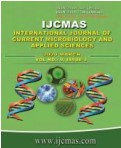


 National Academy of Agricultural Sciences (NAAS)
National Academy of Agricultural Sciences (NAAS)

|
PRINT ISSN : 2319-7692
Online ISSN : 2319-7706 Issues : 12 per year Publisher : Excellent Publishers Email : editorijcmas@gmail.com / submit@ijcmas.com Editor-in-chief: Dr.M.Prakash Index Copernicus ICV 2018: 95.39 NAAS RATING 2020: 5.38 |
Gastrointestinal nematodes (GIN) in ruminants are one of the major impediments in livestock production and causes enormous economic losses. Accurate identification of GIN is essential for studying epidemiology and envisage control programme. The present study describes the generic composition of strongyle affecting goats of mid Himalayan Uttarakhand by polymerase chain reaction based restriction fragment length polymorphism (PCR-RFLP). The faecal samples (N=2231) of goats were collected from different places of Uttarakhand over the period of three years (2016-2018) and screened for strongyle infection by salt floatation. The positive samples were pooled subjected for larval culture. The infective third stage larva obtained from the culture were used for PCR-RFLP using RsaI restriction enzyme on β-tubulin isotype-I gene. The floatation results were indicated that the strongyle infection was present throughout year and the intensity of infection was moderate to severe from mid rainy season to autumn (Mid July to October). The prevalence of GIN infection was 95.78% (2137/2231) and egg per gram was 1982±452. The PCR-RFLP clearly differentiated three common strongyle species of goats such as Haemonchus controtus, Teladorsagia circumcincta and Trichostrongylus colubriformis. Based on PCR-RFLP, the predominant stronglye infections are H.contortus and T. circumcincta in high altitude of Uttarakhand. The results obtained in the present study suggest that the GIN infection is common among goats of mid Himalayan region of Uttarakhand and further it enlighten on timely intervention before the development of clinical disease.
 |
 |
 |
 |
 |